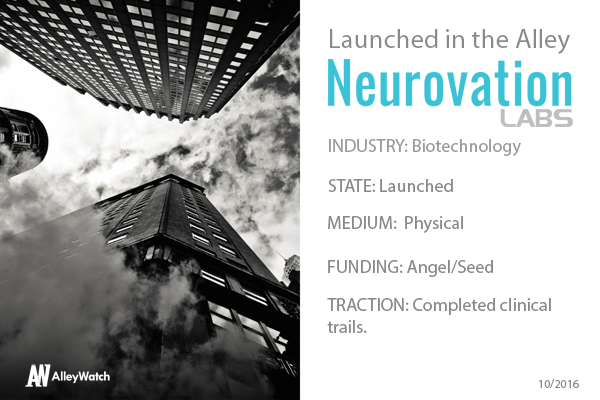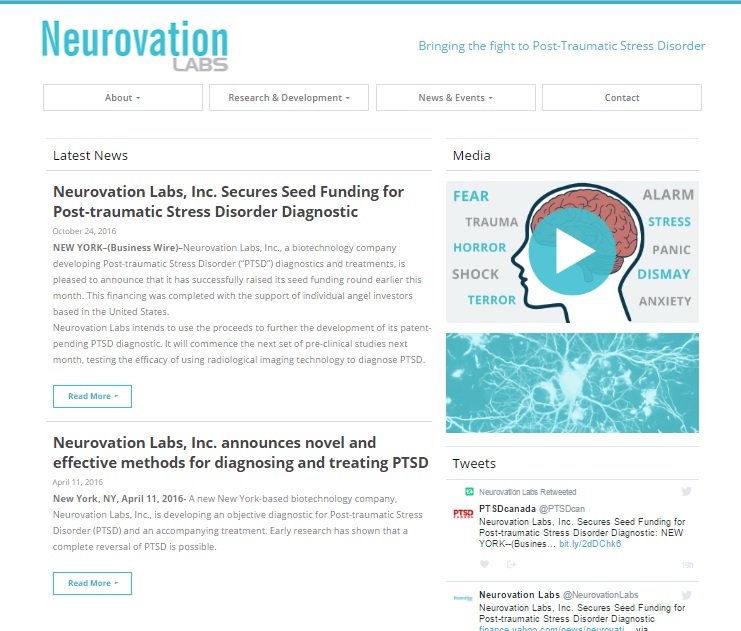
It is estimated that 7.9% of Americans will suffer from some form of PTSD in their lifetime. While this may or may not be a surprising number, the real surprising part is that there is no true diagnostic for diagnosing PTSD . Until Neurovation Labs, the NYC startup that is focused on creating a more scientific diagnosis for the disorder in addition to developing a future treatment that’s based on data and research rather than subjective factors.
AlleyWatch spoke with CEO Jennifer Perusini about the origin of the startup and where its going in the future.
Tell us about the product or service.
Neurovation Labs is developing diagnostics and treatments for Post-Traumatic Stress Disorder (PTSD). The products are based on my doctoral research, which culminated in the discovery of an objective indicator of PTSD—an enduring protein increase after a traumatic event within the part of the brain central to fear learning. It is potentially the first biomarker for detecting the disease.

How is it different?
Currently, there is no true diagnostic for PTSD apart from symptom checklists, and existing treatments are merely symptom-maskers meant for other disorders that have been met with little success. We are tackling both of these shortcomings. First, we are turning concrete scientific data into a true, objective diagnostic. That is, the protein increase we see after a trauma will be detected by a brain scan to diagnose PTSD in patients. Second, we are also developing a companion treatment that will target the same protein increase to relieve symptoms. We are working to produce a drug that for the first time actually targets the underlying cause of the disorder instead of just acting as a band-aid for the symptoms.
What market are you attacking and how big is it?
Our potential market is quite large for this unmet medical need. About 24.4 million people in the U.S. alone suffer from PTSD—that is nearly triple the population of New York City. Our biggest target population is the military and armed forces. Their lifetime risk of developing PTSD is much higher than that of the civilian population (about 30% versus 8%), yet strikingly, they are the least likely to seek medical attention and stick with treatment regimens.
What is the business model?
We plan to complete pre-clinical research for the diagnostic and move into clinical trials within the next twenty-four months. Simultaneously, we will be running a rigorous small molecule drug discovery program to optimize our PTSD treatment. Success in clinical trials would be followed by our go-to-market, first with the diagnostic (which we expect to finish first) and then with the treatment.
What inspired the business?
In 2001, I lost both my mother and my grandfather within weeks of each other. All of this happened immediately after the September 11th attacks, and as a New Yorker, I watched so many in my town lose loved ones. What really struck me was how everyone around me coped so differently with these traumatic events. Some thrived and channeled their frustrations into productivity; some floundered and lost their way. By the time I reached graduate school, I sought to understand coping mechanisms and what happens when they go awry. My doctoral work with my co-founder Dr. Michael Fanselow focused on understanding such mechanisms in a rodent model of PTSD. We felt the model was so strong and the data so translatable that we decided to form a company to bring our research to market.
How do you plan on commercializing your research findings?
We are developing concrete products based on our research. These products—a diagnostic that uses a unique composition of matter and a drug treatment—will provide the basis for commercialization, whether we produce and sell them ourselves or license others to do so.
What are the milestones that you plan to achieve within six months?
Within six months, we plan to have much of the pre-clinical diagnostic research completed. We are currently optimizing the probe to use in our brain scan to determine levels of our biomarker protein. Also within the next six months we expect to break ground on our treatment development. Around the same time we will be seeking Series A funding to finance further research and development.
What is the one piece of startup advice that you never got?
Change is not readily embraced, yet it is often key to a successful startup. Though criticisms may be loud and plenty, it does not mean the idea is not good. Be persistent and others will be forced to embrace the change you are creating.
If you could be put in touch with anyone in the New York community who would it be and why?
While he is really in the greater New York area, we would be thrilled to connect with Steven Cohen, founder of Cohen Veterans Bioscience and the Steven and Alexandra Cohen Foundation, among other organizations. He has pledged hundreds of millions of dollars to combat PTSD, including sponsoring the Cohen Veteran Center at NYU Langone, which recently opened. This center has dedicated its research to improving the detection and treatment of PTSD and other veteran-related disorders. Given our novel approach to PTSD diagnosis and treatment, we feel that a relationship with the Cohen Veterans Network and NYU Langone would prove to be mutually beneficial.
Why did you launch in New York?
After graduate school, I moved back to NYC for a short post-doctoral fellowship. When my co-founders and I started dreaming up Neurovation Labs, most of the team was already living here. The greater New York area and the northeast is a major hub for healthcare, and we felt we would fit right in here. Also, living through September 11th and watching the mental health deterioration in its aftermath was the biggest motivation behind this research, so we felt there would be no better home for the company than New York.
Where is your favorite fall destination in the city?
Honestly, in the fall I love to leave the city every now and then back home to my native Rockland County. Out there, you really get to appreciate the fall foliage. But if I’m staying in NYC, watching the leaves change color around the reservoir in Central Park more than suffices.




